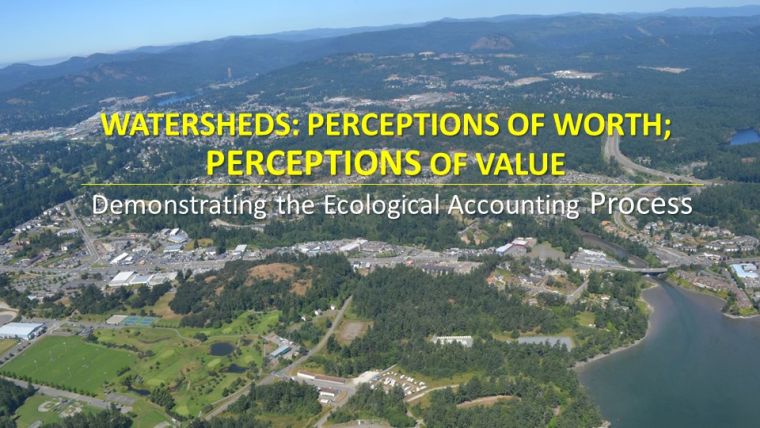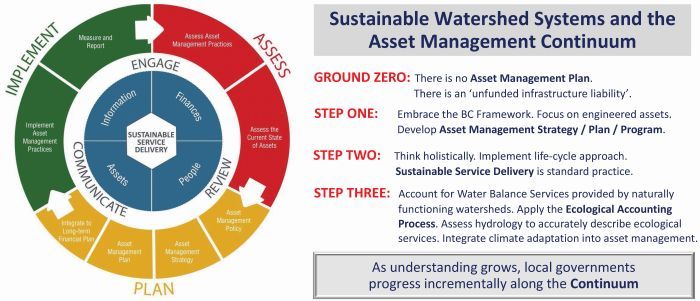Changing the Way We Do Business in British Columbia: “EAP – the Ecological Accounting Process – is a whole-system view of watersheds that assesses hydrology in order to accurately describe ecological services,” states Tim Pringle
NOTE TO READER:
The rhythms of water are changing in British Columbia – winters are wetter and warmer; summers are longer and drier. Adapting to climate change requires transformation in how we perceive watershed worth and service land. In April 2018 (on the 11th and 12th), the Nanaimo Water Symposium is designed to foster a conversation in the mid-Vancouver Island region and beyond about:
(1) the good things that flow from local government and stewardship sector collaboration;
(2) the over-arching role played by the innovative and precedent-setting Drinking Water & Watershed Protection Program in the Regional District of Nanaimo; and,
(3) the first demonstration applications of the Ecological Accounting Process (EAP) to assess “watershed worth”.
The symposium is an outreach and professional development event, held under the umbrella of the Georgia Basin Inter-Regional Education Initiative.
Download a copy of the PROGRAM BROCHURE
To register, visit https://www.civicinfo.bc.ca/event/2018/Nanaimo-Water-Symposium

Look at Watersheds Differently: ‘Worth’ versus ‘Value’
Tim Pringle will talk about the Ecological Accounting Process (EAP). It is one of three streams of deliverables flowing from Sustainable Watershed System, through Asset Management. Funded by the governments of Canada and British Columbia, this initiative is led by the Partnership for Water Sustainability. Tim Pringle is the Chair, EAP Initiative.
 “EAP is a whole-system view of watersheds that assesses hydrology in order to accurately describe ecological services,” states Tim Pringle. “Our first two demonstration applications are Busy Place Creek watershed in the Cowichan Valley; and Brooklyn Creek watershed in the Comox Valley.
“EAP is a whole-system view of watersheds that assesses hydrology in order to accurately describe ecological services,” states Tim Pringle. “Our first two demonstration applications are Busy Place Creek watershed in the Cowichan Valley; and Brooklyn Creek watershed in the Comox Valley.
“Looking through the ‘worth lens’ has led to a fundamental shift in the EAP approach: place less emphasis on monetization of ecological services; instead, focus on the investment of resources as well as aspirations of motivated stakeholders.
“The vision for EAP is that it would help local governments in British Columbia progress along the Asset Management Continuum for Sustainable Service Delivery. Once a life-cycle approach is standard practice, the next logical step is to integrate ecological services from natural systems into asset management.”
Two Early Conclusions
“Initially, we saw EAP as a tool (i.e. ‘the protocol’) that would help practitioners calculate the opportunity cost of balancing ecological services with drainage infrastructure,” continues Tim Pringle.
“However, our thinking has evolved over the past year. Testing the approach through two demonstration applications has resulted in this defining conclusion: EAP is a process, not a protocol. Thus, we are rebranding EAP as the Ecological Accounting Process.
“This is one of two early conclusions. The second relates to the distinction between worth and value.”
A Process, not a Protocol
“The term ‘Process’ more accurately describes the challenge of working with multiple stakeholders to assess the hydrology of an entire creekshed, or small watershed, in order to accurately describe the ecological services made possible by the hydrology.
“This comprehensive approach rarely takes place and it makes the Ecological Accounting Process (EAP) unique,” emphasizes Tim Pringle.
Framework for Undertaking Demonstration Applications
“When we designed EAP, there were no predetermined outcomes, but there were goals,” reports Tim Pringle.
“Goal #1 is to study two creeksheds with differing levels of alterations of the landscape and responses to the physical change.
“Goal #2 is to apply the Water Balance Methodology as the analytical tool to assess the functioning condition of the creekshed hydrology.
“Goal #3 is to confirm the definable benefits of the ecological services supported by the hydrology.
“Goal #4 is to produce a social and financial account about the worth of these services.”
To Learn More:
Visit https://waterbucket.ca/gi/category/ecological-accounting-process/, the EAP homepage on the Green Infrastructure community-of-interest.
The Nanaimo Water Symposium is also designed to foster a conversation in the mid-Vancouver Island region and beyond about the transformational scope of the “Sustainable Watershed Systems, through Asset Management” program.


